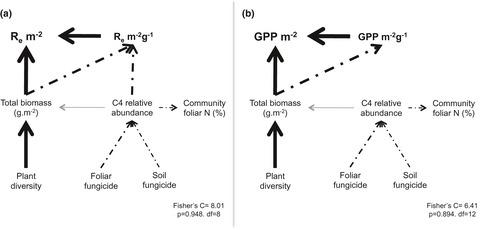当前位置:
X-MOL 学术
›
Ecol. Lett.
›
论文详情
Our official English website, www.x-mol.net, welcomes your
feedback! (Note: you will need to create a separate account there.)
Foliar fungi and plant diversity drive ecosystem carbon fluxes in experimental prairies
Ecology Letters ( IF 7.6 ) Pub Date : 2020-12-09 , DOI: 10.1111/ele.13663 Mayank Kohli 1 , Jeremiah A. Henning 1, 2 , Elizabeth T. Borer 1 , Linda Kinkel 3 , Eric W. Seabloom 1
Ecology Letters ( IF 7.6 ) Pub Date : 2020-12-09 , DOI: 10.1111/ele.13663 Mayank Kohli 1 , Jeremiah A. Henning 1, 2 , Elizabeth T. Borer 1 , Linda Kinkel 3 , Eric W. Seabloom 1
Affiliation

|
Plant diversity and plant–consumer/pathogen interactions likely interact to influence ecosystem carbon fluxes but experimental evidence is scarce. We examined how experimental removal of foliar fungi, soil fungi and arthropods from experimental prairies planted with 1, 4 or 16 plant species affected instantaneous rates of carbon uptake (GPP), ecosystem respiration (Re) and net ecosystem exchange (NEE). Increasing plant diversity increased plant biomass, GPP and Re, but NEE remained unchanged. Removing foliar fungi increased GPP and NEE, with the greatest effects at low plant diversity. After accounting for plant biomass, we found that removing foliar fungi increased mass‐specific flux rates in the low‐diversity plant communities by altering plant species composition and community‐wide foliar nitrogen content. However, this effect disappeared when soil fungi and arthropods were also removed, demonstrating that both plant diversity and interactions among consumer groups determine the ecosystem‐scale effects of plant–fungal interactions.
中文翻译:

叶真菌和植物多样性驱动大草原生态系统的碳通量
植物多样性和植物-消费者/病原体的相互作用可能相互作用,从而影响生态系统的碳通量,但缺乏实验证据。我们研究了从种植有1、4或16种植物的实验大草原中实验去除叶真菌,土壤真菌和节肢动物如何影响瞬时碳吸收率(GPP),生态系统呼吸(R e)和净生态系统交换(NEE)。增加植物多样性增加了植物生物量,GPP和R e,但NEE保持不变。去除叶真菌提高了GPP和NEE,在植物多样性较低的情况下效果最大。在考虑了植物生物量之后,我们发现去除叶面真菌会通过改变植物物种组成和整个社区的叶面氮含量而提高低多样性植物群落的质量比通量率。然而,当土壤真菌和节肢动物也被去除时,这种影响消失了,这表明植物多样性和消费者群体之间的相互作用决定了植物与真菌相互作用的生态系统规模效应。
更新日期:2021-02-12
中文翻译:

叶真菌和植物多样性驱动大草原生态系统的碳通量
植物多样性和植物-消费者/病原体的相互作用可能相互作用,从而影响生态系统的碳通量,但缺乏实验证据。我们研究了从种植有1、4或16种植物的实验大草原中实验去除叶真菌,土壤真菌和节肢动物如何影响瞬时碳吸收率(GPP),生态系统呼吸(R e)和净生态系统交换(NEE)。增加植物多样性增加了植物生物量,GPP和R e,但NEE保持不变。去除叶真菌提高了GPP和NEE,在植物多样性较低的情况下效果最大。在考虑了植物生物量之后,我们发现去除叶面真菌会通过改变植物物种组成和整个社区的叶面氮含量而提高低多样性植物群落的质量比通量率。然而,当土壤真菌和节肢动物也被去除时,这种影响消失了,这表明植物多样性和消费者群体之间的相互作用决定了植物与真菌相互作用的生态系统规模效应。











































 京公网安备 11010802027423号
京公网安备 11010802027423号